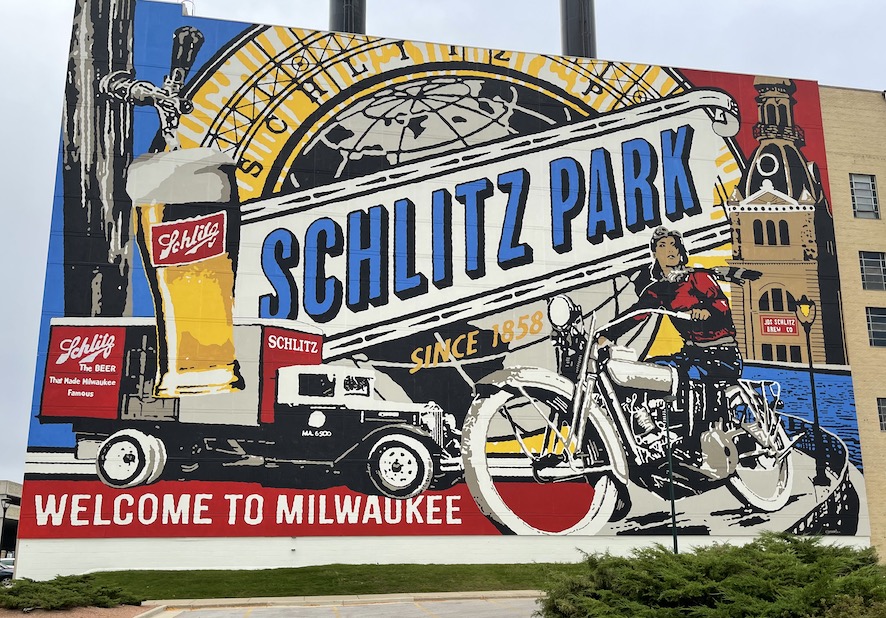
Schlitz Park is today one of the nation’s most unusual office complexes, spread throughout the renovated former Schlitz Brewery buildings. Photo by David DeVoss
By Mark Orwoll
“Have you ever closed Wolski’s?”
That’s not an uncommon question in this city. If your answer is yes, you’re considered a true Milwaukeean. Bumper stickers bearing the slogan “I closed Wolski’s” have been spotted not just in Milwaukee, but in the most unlikely places as a badge of honor, the emblem of an insider.
Wolski’s, and Milwaukee in general, attracts travelers from across America and from around the world. Visit Milwaukee’s website is translated into 12 languages, including Chinese, Spanish, Portuguese, Italian, Hindi, Polish, and, of course, German.
The inconspicuous Wolski’s Tavern in the city’s Lower East Side sits on modest, residential Pulaski Street, the last place you’d expect to find a Milwaukee icon. You can’t buy food at Wolski’s. You’re served beer. And you’re not getting the I Closed Wolski’s bumper sticker unless you stay until the 2 a.m. closing.
As I enter the crowded drinking establishment on a late Sunday afternoon, the small space is tight with customers three deep at the bar—everyone from college girls and handsome young guys to middle-aged dads and retirees. A pool table in back and a few dart boards are the saloon’s entire recreational attractions. The bar itself bears witness to more than a century of slinging booze. The popcorn is free, the atmosphere jovial.
A young man says he wants to settle up, hands the bartender some bills, and receives not only his change but a bottle of Miller Lite.
“Come on,” the barman says, “you’re not done yet.”
The young man does his best to slug it down, but it’s slow going.
I ask my neighbor if the adjacent seat is free, pull the empty stool back from the bar, and order a Miller High Life. The bartender returns to the young man with the Miller Lite, who is attempting to leave his half-full bottle at the bar.
“Now, now, you know how many people around the world would give their arm for a bottle of that?” he says accusingly. “We don’t waste things in this bar. Drink up.”
The young man takes a deep breath, then pours the remainder into his mouth.
The man sitting next to me, a criminal-defense attorney named Tom, is watching the scene with detached bemusement. He’s been drinking at Wolski’s for years. He sees the slight concern on my face as I witness the beer-drinking scene with the young man and the barkeep.
“The bartender knows everyone here,” says Tom placatingly, “knows where they live, how they got here, how they’re getting home, and pretty much their blood-alcohol level so he can stop serving them if necessary.”
Pretty good bartender.
“This is our version of Cheers,” says Tom. “Thankfully everything stays the same. See that display case over there with the T-shirts? That hasn’t changed since at least the Nineties.”
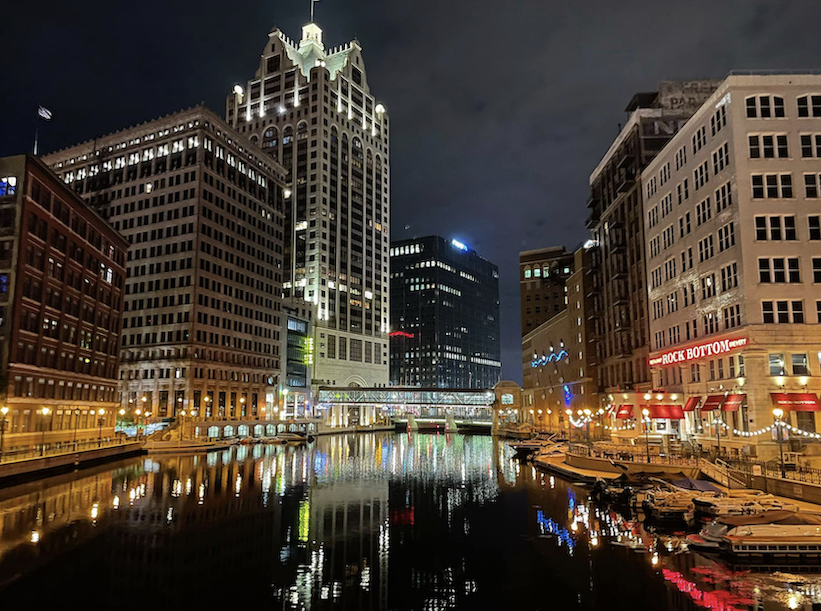
The Milwaukee River, running through the heart of downtown, was one of the abundant sources of water that attracted German brewers to the city in the mid-1800s. Photo by Visit Milwaukee
The Most German City in America
“There were about 2,000 saloons in Milwaukee before Prohibition,” says John Gurda, local historian and author of several books about the city, including The Making of Milwaukee. We’re having tea at Café Nō, an industrial-chic coffeehouse in the former research lab for Pabst Brewery. “About two-thirds of them were what were called tied houses. That meant that they sold only one brewery’s products. Miller was not a national brewery until after World War II. But at one time they were the local leader in terms of sales volume, and they had a lot of tied houses. They were a really big deal. Pabst was a big deal. Schlitz was a big deal. Blatz was another.”
Those breweries had one simple thing in common: They were all started by immigrants from Germany. Pabst, begun in 1844, became an industry giant under Captain Frederick Pabst. He was from Mönchpfiffel-Nikolausrieth. Pabst’s chief rival was Joseph Schlitz from Mainz, who started his eponymous brewing company in 1849. Valentin Blatz, of Miltenberg, began brewing in Milwaukee in 1850. And Frederick J. Miller, from Riedlingen, christened his self-named brewery in 1855.
“At one point, Milwaukee was the most German city in America,” says Gurda. “In a lot of ways, the [brewing industry] was simply a natural expression of the Germanism of Milwaukee. It was something you would have expected in a town with this many Germans and such a highly developed taste for beer.”
Even today, that heritage runs through Milwaukee’s veins.
“In the last census,” says Gurda, “Milwaukee still had the highest concentration of German ancestry in the country, even though they don’t all wear lederhosen and eat sausage for breakfast.”
The Donauschwaben Arrive
One of the unique groups of Germans in Milwaukee today are those who lived outside their native land in the 18th century along the Danube in Hungary, Romania, and the former Yugoslavia. They’re called the Donauschwaben, which means Danube Swabians. (Swabia is a region of southwest Germany.) In the years following World War II, thousands of them immigrated to the United States, and to Milwaukee in particular, where nine families formed what would later become the United Donauschwaben of Milwaukee. There are now more than 200 members, including children.
Mary Ann MacGillis was born in Milwaukee to Donauschwaben parents and didn’t learn English until kindergarten. Today she is the Ehren (emeritus) president of the United Donauschwaben of Milwaukee and a historian of the organization.
“We have a very strong dialect,” she tells me during lunch at Mader’s, one of Milwaukee’s old-school German restaurants. “It’s German but, like English in New Orleans, you have to listen twice to figure out what’s being said. Our costumes are a little bit different than you might find in Germany proper. Something as simple as the way an apron is tied or a feather in a hat can distinguish a person between one village and another.”
In 1966, the organization banded with the Milwaukee Sport Club, a Donauschwaben soccer organization, to buy a clubhouse in nearby Menomonee Falls, called the Schwabenhof. They formed dance groups, established a ladies’ auxiliary, and gave the men free rein to trap shoot and play cards as members of the Jaegerverein. They held picnics so that their food traditions could be preserved and taught to the outside world. And they hosted a popular Oktoberfest.
“We still have those events today,” says MacGillis. “Our Father’s Day picnic and large Oktoberfests are very popular. Also very successful is a Thursday-night beer garden I operate from June to Oktoberfest. Those are some of the ways we try to preserve our heritage.”
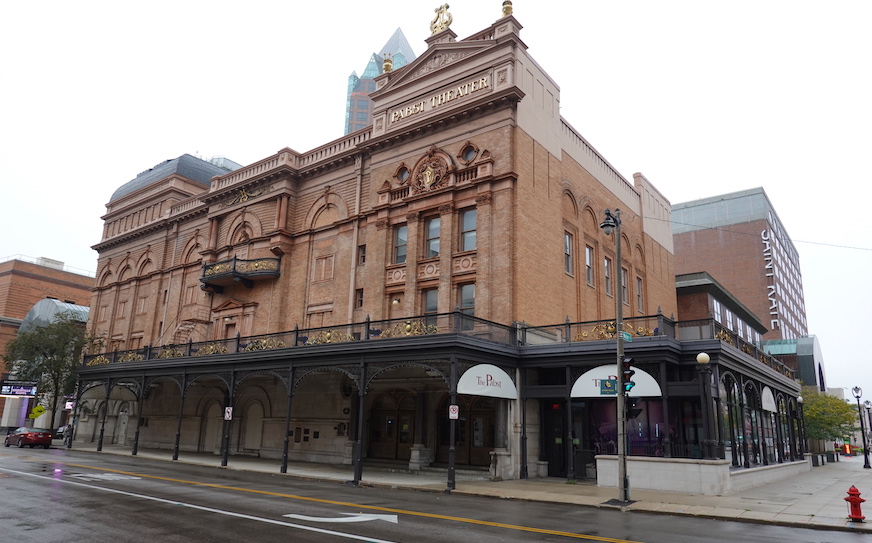
Milwaukee’s breweries were well loved not just because they offered employment, but because they supported many local annual events and underwrote such cultural institutions as the Pabst Theater. Photo by David DeVoss
Yes, but Why Milwaukee?
The Donauschwaben came to Milwaukee because so many Germans already resided there. But the early-day German immigrants could have settled anywhere. Why did they choose Milwaukee? I go in search of the answer at the Milwaukee County Historical Society’s ongoing exhibition “Brew City: The Story of Milwaukee Beer.” There I meet Ben Barbera, the organization’s director of collections and exhibitions, and put the question to him.
“Climate was a part of it,” Barbera says. “A lot of them were farmers in Germany, and the climate was similar. You need a good source of water [for brewing], and we have it. Also, you need a place to store lager beer, so the brewers went to parts of the city to dig caves that they would pack with ice. There was a railroad line. Plus, the grain they needed was grown in this region.”
On a recent visit, I wanted to touch and be surrounded by Milwaukee’s German history and its brewing heritage. So, I set my sights on the former Pabst Brewery, a vast campus on a hill just northwest of downtown with splendid views of the city. There, in the 1800s, Pabst built bottling plants, brewing warehouses, office buildings, shipping facilities, all constructed in a castle-like style of architecture with crenelations, towers, thick stone walls, and arched entryways. The brewery was almost like its own village, with public streets crisscrossing among its various structures.
The Pabst Campus
The main brewing building today is the Brewhouse Inn & Suites, a comfortable and welcoming hotel whose decorative focal point is the original six copper brewing kettles that are still in place. Adorned with massive exhaust pipes, 19th-century gearboxes and industrial ladderlike stairways, the hotel’s interior could have been the inspiration for the steampunk genre of art and literature.
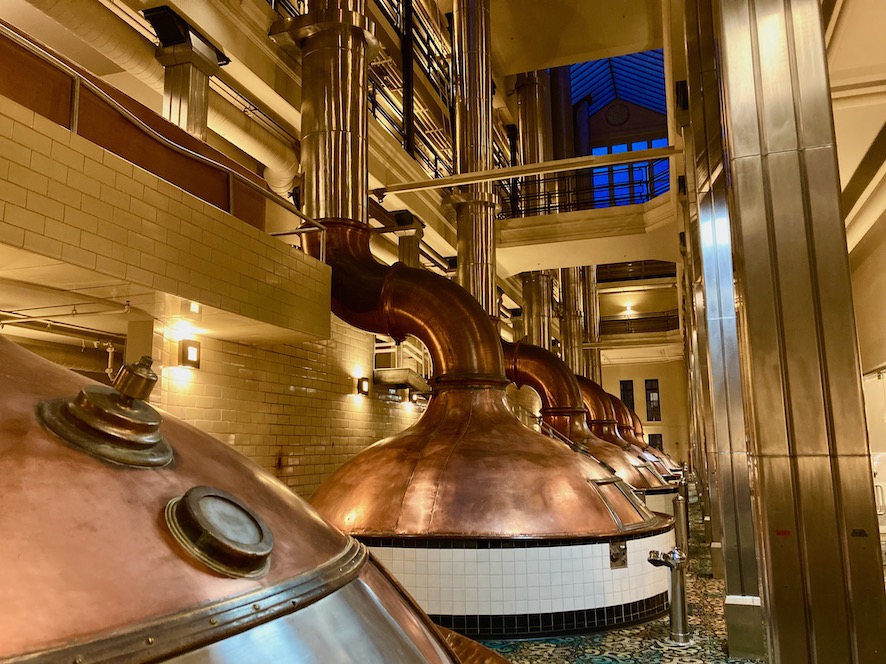
Pabst’s original copper brewing kettles lend a dramatic air to the atrium of the Brewhouse Inn & Suites on the Pabst campus overlooking downtown Milwaukee. Photo by Mark Orwoll
Elsewhere among the aging brewery buildings: Nō Studios, a collaborative arts workspace and social center started by Oscar-winning screenwriter John Ridley (12 Years a Slave); nine restaurants and cafés, including small-batch beer-maker Pilot Project Brewing; the University of Wisconsin-Milwaukee’s School of Public Health; lofts for students and condos for seniors; offices for small start-ups of all sorts; and Best Place at the Historic Pabst Brewery in the former Pabst executive office building, where beer-history tours include a tallboy of Pabst Blue Ribbon.
So much is going on in and around the old Pabst Brewery that the city of Milwaukee has given it a formal appellation: the Brewery District.
Though it was the most prominent brewery, thanks to its position on the hilltop and its attractive buildings, Pabst was not always the top seller.
“Pabst was number one in the country from 1874 until 1900,” says historian John Gurda. “Schlitz took the lead in 1901, and then there was a lot of swapping back and forth among Schlitz, Pabst, and Anheuser-Busch [of St. Louis]. But Pabst and Schlitz were the big boys in town.”
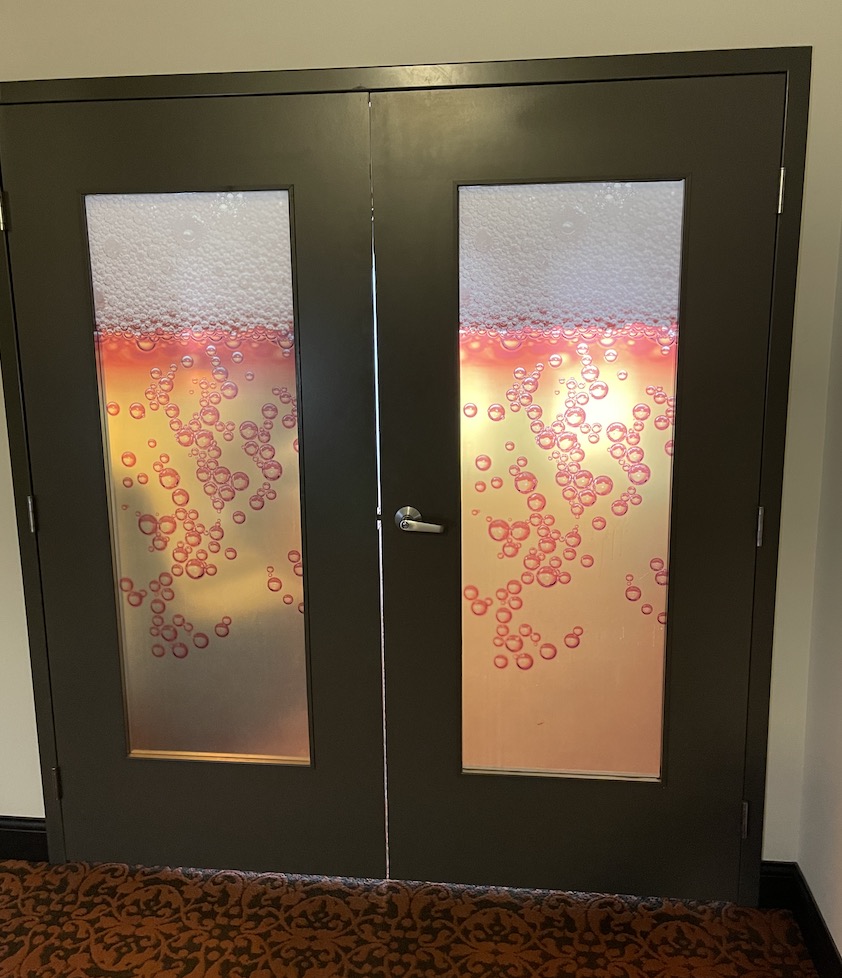
Doors leading into public spaces and off of hallways have an unusual motif at the Brewhouse Inn & Suites in Milwaukee. Glass embedded in the doors is colored and textured to resemble a freshly-poured pint of beer. Photo by David DeVoss
Beer Barons
Joseph Schlitz took over his brewery by marrying the founder’s widow. Valentin Blatz expanded his brewery by marrying the widow of a rival brewer.
“If you wanted to be a beer baron in Milwaukee, your best bet was to marry a beer baron’s widow,” says Ben Barbera of the Historical Society.
But Frederick Pabst earned his right to own his father-in-law’s brewery.
Pabst was a German immigrant to Chicago, worked on Great Lakes sailing ships as a cabin boy at age 14, and became the captain of his own ship at 21. In Milwaukee, to which Pabst often sailed, he met passenger Maria Best and fell in love. Maria was the daughter of Phillip Best, a scion of the nation’s most successful brewing family. Maria and Captain Pabst married in 1862, and Maria’s father offered to sell half-ownership in the Best and Co. Brewery to his new son-in-law. Pabst preferred his life on the water, though. Not until 1863 did he change his mind, but only after he was forced to ground his ship on the shores of Whitefish Bay, just north of Milwaukee, during a fierce storm. He didn’t inherit ownership; he paid for it, a fact that was a point of pride to him for the rest of his life.
“Captain Pabst was proud that he paid for his interest in the brewery,” says Scott Smith, manager of the Best Place at the Historic Pabst Brewery. “That’s unlike some of his competitors, like Valentin Blatz and Joseph Schlitz, who married into their breweries.”
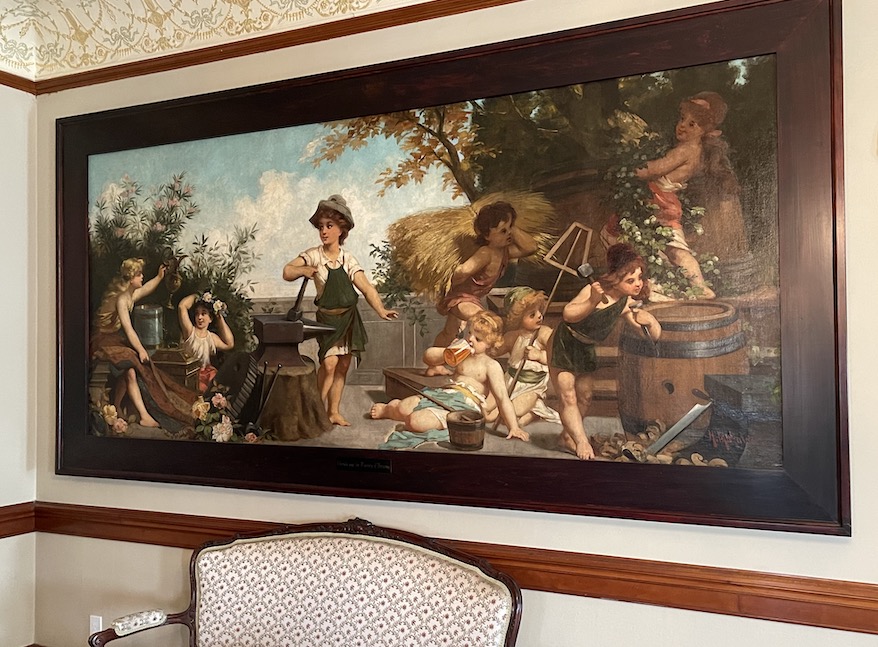
‘The Art of Brewing’ by Hermann Michalowski (German, 1860-1903), 1893, one of the hundreds of artworks in the Pabst Mansion, would today be considered politically incorrect for its innocent portrayal of underage drinking. Photo by David DeVoss
+With his well-earned wealth, Captain Pabst built a phenomenal mansion on Grand Avenue, which was then the poshest street in the city. The 20,000-square-foot stately home, completed in 1892, is today the only intact manor house remaining on that street, now renamed West Wisconsin Avenue.
“It was a trophy home,” says my guide, Maryann Wieczorek, during a tour of the mansion.
On the walls and plinths are 120 works of art. Fourteen fireplaces made the rooms cheerful, while plumbing and heating systems kept residents comfortable. Rare and valuable wood was used to highlight the differences in the various rooms—cherry, mahogany, oak, birch, and more.
Among the rooms is the Ladies’ Parlor in the French Rococo style. The ivory-painted walls and ceiling are decorated with garlands and scrollwork coated in gold leaf. In the Pabst’s enormous bedroom suite on the second floor, I notice a platform raised three or four inches higher than the floor and edged by an ornate cherrywood railing. I ask Wieczorek what its purpose might have been, but she doesn’t know.
“There are still secrets in this house that we haven’t figured out,” she says.
After Pabst’s death, the family sold the mansion in 1908 to the Archdiocese of Milwaukee for use as the personal home of the archbishop. The archdiocese sold it to a developer in 1975, the same year it was placed on the National Register of Historic Places, a distinction that made it more difficult to demolish the structure. It was sold again to the nonprofit Captain Frederick Pabst Mansion, Inc., which has been restoring the grand house ever since. The mansion opened as a museum in 1978 and offers regular tours to the public.
Brewing—Important, But Not the Only Game in Town
Despite the wealth of Pabst and his fellow beer barons, brewing was not Milwaukee’s primary industry.
“Perception always lags behind reality,” says historian Gurda. “There’s only one year in which brewing was our most important product, and that was 1890. Ever since, for decades after that, it was durable goods, especially metal-bending industries. Milwaukee was more of a factory town than a brewery town. The fact that Milwaukee has such a strong brewing reputation is largely based on beer being a massively advertised consumer product.
“You couldn’t get close to a TV in the Seventies that wasn’t airing a ‘Tastes great! Less filling!’ commercial for Miller Lite. You still hear, ‘The beer that made Milwaukee famous.’ It was such a ubiquitous tagline that it survived and remains part of the culture.”
Surprisingly, there are more than 40 breweries in Milwaukee today (mostly craft breweries) compared to just 26 before the Civil War.

Three of the Big Four brewers, as well as many of the city’s social and political elite, were buried in Milwaukee’s Forest Home Cemetery. Photo by David DeVoss
End of an Era
The final years of the Big Four, were characterized by financial reversals. Miller lives on as part of Molson Coors, but Blatz kicked the beer bucket in 1959. Schlitz, after a labor dispute, tapped its last keg in 1982. And Pabst ceased independent brewing in 1996. Today, Schlitz, Pabst Blue Ribbon and other classic beers like Olympia, Lone Star and Strohs live on thanks to San Antonio-based Pabst Brewing Company, which now is a marketing entity that owns several old-guard beer trademarks.
One indication of the continuing popularity of Pabst Blue Ribbon is that it’s also produced in China, where Pabst Blue Ribbon 1844 sells for $44 a bottle.
The fact that Milwaukee’s classic beers no longer are headquartered in Milwaukee still rankles. “The loss of Schlitz was the big one,” says John Gurda. “It sponsored the circus parade and lakefront fireworks on July third. Pabst had the Holiday Folk Fair and continued operations until 1996, but when Schlitz closed in 1982 it was an identity crisis. They were closing what was at the time Milwaukee’s largest brewery.”
The Tradition Lives On
There are many signs of an optimistic future for Milwaukee’s brewing industry.
One of the veterans of the new breed of Milwaukee breweries, and one of the most successful, is Lakefront, started in 1987 by brothers Russ and Jim Klisch. Their brewery tour and beer hall are among the most popular beer attractions in the city. Sitting in Lakefront’s capacious and crowded beer hall, I ask Jim whether the city’s brewing history was much on his mind when he and Russ began their business some 35 years ago.
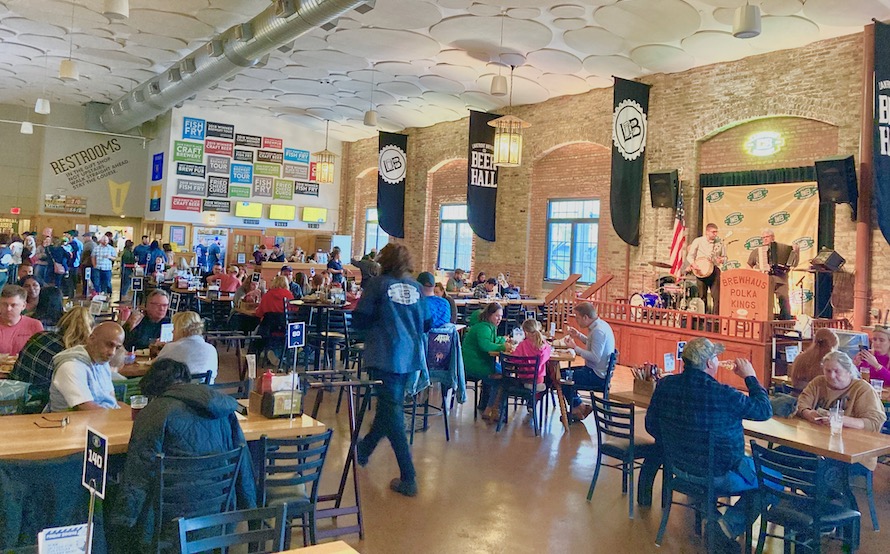
Lakefront Brewery draws hundreds of craft-beer lovers daily for food, drink and entertainment in the massive beer hall and for the popular brewery tour, including tasting samples. Photo by Mark Orwoll
“We wanted to carry on that tradition,” he says. “We really felt that. We thought, if nothing else, we’ll have a little craft brewery, and see where it leads to.”
Where it has led is distribution throughout Wisconsin and 30 other states across the country. Clearly, Milwaukee’s beer-brewing prowess isn’t just a lesson for the history books.
Elsewhere, the city’s German and central European heritage carries on in its restaurants (Kegels Inn, 1924; Jack Pandl’s Whitefish Bay Inn, 1915; Von Trier, c. 1930), purveyors (Usinger’s butcher, 1880; Wisconsin Cheese Mart, 1930), and the few remaining former tied houses.
On my last day in Milwaukee, on my way to Mitchell International for my flight home, I stop at a tavern in the nondescript Walker’s Point neighborhood southwest of downtown. The streets are full of warehouses, century-old brick office buildings and former dormitories for factory workers. But at the corner of East Florida Street and South First Street, a beacon of warmth and joy lends some humanity to the area, a place of sustenance and good cheer.
O’Lydia’s is just a bar, a former tied house with the Pabst Brewery. But it has been a source of good drink and camaraderie in Milwaukee for legions of factory workers since 1893.
As soon as I walk through the door and take a seat at the bar, I feel right at home. I order lunch and a beer and am served right away. A woman to my right says my food looks delicious, and before you know it, I’m hearing the story of how she and her boyfriend live separately but own a vacation home together for weekend getaways. “But we’re not getting married,” she insists. “I’ve been married once before, and once was enough!”
On my left, a couple from Chicago is calculating the best route for the 90-minute drive home.
“Oh, the highways look fine on Google Maps, but they’re tearing things apart down in the city,” says the man. “I’m trying to figure out the best surface streets.”
I haven’t been in the bar for more than 20 minutes, and already I’m intimate with people I’ve never met before in my life. I know their personal history, where they live, the kind of beer they drink. I feel good where I am.
I feel good to be in Milwaukee.![]()
Mark Orwoll, a frequent contributor to East-West News Service, is the former International Editor of Travel + Leisure. Please see his recent articles on Climate Changes Comes to Austria’s Alps and Where to Find the Soul of America.

